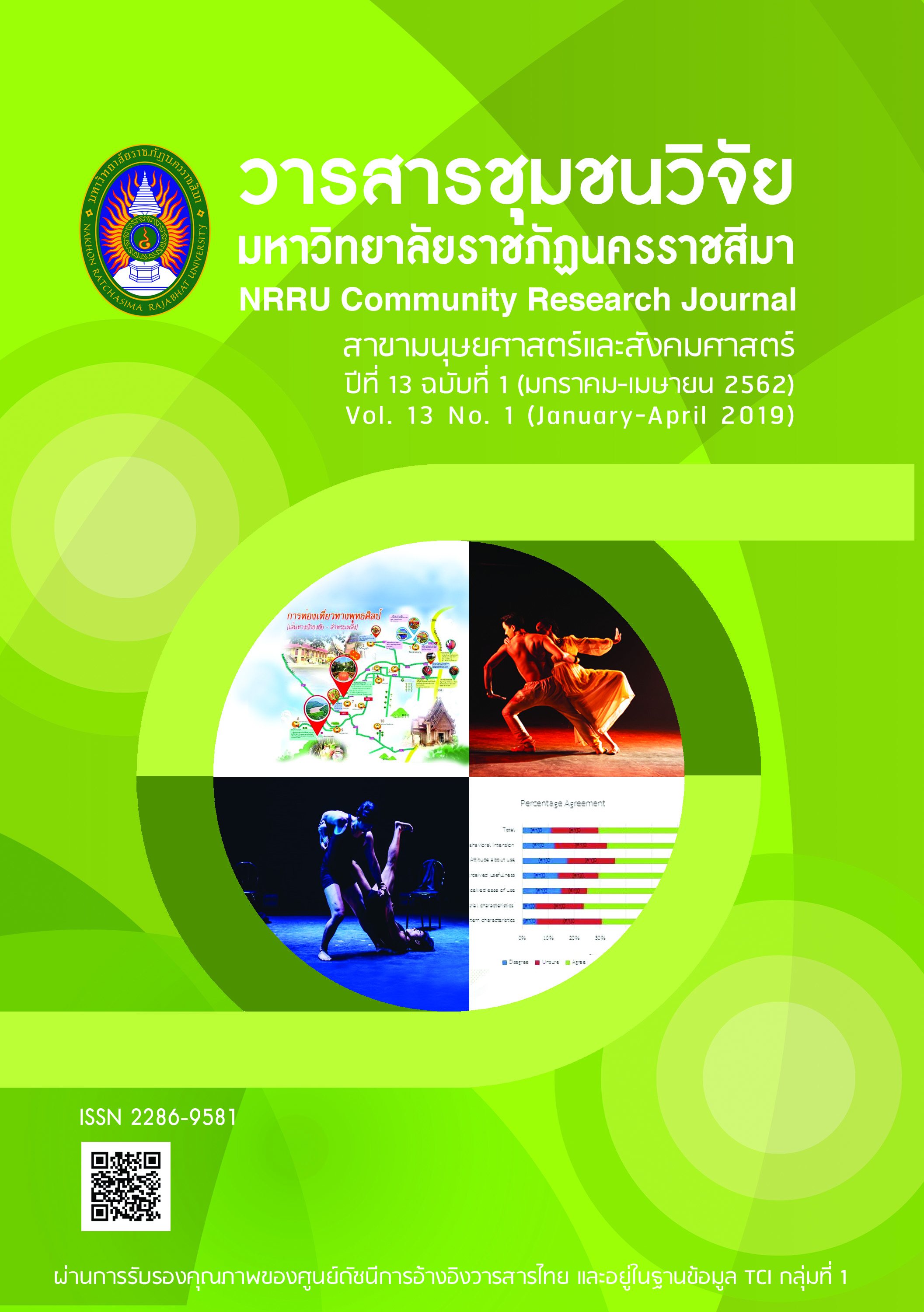การใช้รูปแบบการเรียนรู้แบบห้องเรียนกลับด้าน แบบร่วมมือกันในรายวิชาการอ่านเพื่อความเข้าใจ
DOI:
https://doi.org/10.14456/10.14456/nrru-rdi.2019.9คำสำคัญ:
ความเข้าใจในการอ่าน, ห้องเรียนกลับด้าน, การเรียนแบบร่วมมือกัน, การนำรูปแบบไปใช้บทคัดย่อ
วัตถุประสงค์ของการวิจัยครั้งนี้เป็นประเมินผลการใช้และหาแนวทางการปรับปรุงรูปแบบการเรียนรู้แบบห้องเรียนกลับด้านแบบร่วมมือกัน สำหรับรายวิชาการอ่านเพื่อความเข้าใจ รูปแบบการเรียนนี้ดัดแปลงมาจากรูปแบบการเรียนกลับด้านเพื่อให้เหมาะสมกับเป้าหมายรายวิชา ลักษณะเด่นของรูปแบบการเรียนนี้คือมีการนำองค์ประกอบด้านการเรียนรู้แบบร่วมมือกันเข้าไปในกิจกรรมการเรียนออนไลน์และการเรียนในห้องเรียนและการนำองค์ประกอบด้านระบบบริหารจัดการการเรียนรู้มาช่วยในการเรียนออนไลน์ รูปแบบถูกนำไปใช้กับชั้นเรียนของนักศึกษาภาษาอังกฤษ 32 คนที่มหาวิทยาลัยราชภัฏนครราชสีมา ผลการใช้รูปแบบถูกประเมินโดยใช้คะแนนก่อนการทดสอบ/หลังการทดสอบของนักเรียนและการตอบสนองของนักเรียนต่อแบบสอบถามประสบการณ์การเรียนรู้ แบบสอบถามมีทั้งหมด 36 รายการที่มีความตรงตามเนื้อหาโดยรวมเท่ากับ 0.76 สถิติที่ใช้ในการวิเคราะห์ข้อมูลประกอบด้วยการทดสอบที ความถี่และค่าเฉลี่ย คำตอบจากคำถามแบบปลายเปิดถูกวิเคราะห์โดยใช้วิธีการวิเคราะห์เนื้อหา ผลการประเมินโดยผู้เชี่ยวชาญพบว่า การเรียนรู้แบบห้องเรียนกลับด้านแบบร่วมมือกัน มีความเหมาะสมอยู่ในระดับมาก ผลการใช้งานรูปแบบพบว่านักศึกษาที่เรียนผ่านการเรียนรู้แบบห้องเรียนกลับด้านแบบร่วมมือกัน มีผลการทดสอบก่อนเรียนและหลังเรียนไม่แตกต่างกัน ผลการตอบแบบสอบถามจากการเรียนด้วยการเรียนรู้แบบห้องเรียนกลับด้านแบบร่วมมือกัน พบว่า นักศึกษาส่วนใหญ่มีความคิดเห็นในเชิงบวกกับการเรียนรูปแบบการเรียนรู้แบบห้องเรียนกลับด้านแบบร่วมมือกัน และระบบการเรียนออนไลน์ ผลการศึกษาพบข้อเสนอแนะสำหรับปรับปรุงส่วนต่าง ๆ เพื่อให้การเรียนรู้แบบห้องเรียนกลับด้านแบบร่วมมือกัน เป็นระบบที่มีความเหมาะสมสำหรับการใช้สอนรายวิชาการอ่านเพื่อความเข้าใจบริบทของมหาวิทยาลัยที่นักศึกษาเรียนอยู่ และสามรถนำไปไปประยุกต์ใช้กับการเรียนการสอนที่มีลักษณะคล้ายกัน
References
Bishop, J. L., & Verleger, M. A. (2013). The flipped classroom: a survey of the research. In ASEE National Conference Proceedings, GA : Atlanta.
Boonyapakob, K., Vivekmetakorn, C. K., & Jitpranee, J. (2012). Teachers’ Instructional Practices in Large EFL Classes in a Thai University Context. SALT.
Chomchaiya, C. & Dunworth, K. (2008). Identification of Learning Barriers Affecting English Reading Comprehension Instruction, as Perceived by ESL Undergraduates in Thailand. Edith Cowan University. EDU-COM International Conference, 96-104.
Chomchaiya, C. (2014). An investigation into the development of English language reading comprehension among Thai undergraduate students using an online blended learning approach. Degree of Doctor of Philosophy, Curtin University, Singapore .
Enfield, J. (2013). Looking at the Impact of the Flipped Classroom Model of Instruction on Undergraduate Multimedia Students at CSUN. TechTrends TECHTRENDS TECH TRENDS, 57(6), 14-27. doi: 10.1007/s1152801306981
Erbil, D. G., & Kocabas, A. (2016, September). The Flipped Classroom Based On Cooperative Learning Method in Elementary Schools: Possibilities and A Model Proposal. Intercultural Education at the Crossroads Conferenve in which organized between the dates of 5-9 September 2016. Budapest, Hungary.
Gulbinskienė, D., Masoodi, M., & Šliogerienė, J. (2017). Moodle as Virtual Learning Environment in Developing Language Skills, Fostering Metacognitive Awareness and Promoting Learner Autonomy. Pedagogika, 127(3), 176-185.
Hayikaleng, N., Nair, S. M., & Krishnasamy, H. N. (2016). Thai students’ L2 reading comprehension level for lower order thinking skills and higher order thinking skills questions. Journal of Applied Linguistics and Language Research, 3(5), 83-91.
Huang, Y. N., & Hong, Z. R. (2016). The effects of a flipped English classroom intervention on students’ information and communication technology and English reading comprehension. Educational Technology Research and Development, 64(2), 175-193.
Jacob, E., Rottenberg, L., Patrick, S., & Wheeler, E. (1996). Cooperative learning: Context and opportunities for academic English. TESOL Quarterly, 30, 253-280.
Jing, M. (2016). The application of Moodle-based platform in college English learning. Sino-US English Teaching, 13(5), 332-337.
Karimi, M., & Hamzavi, R. (2017). The Effect of Flipped Model of Instruction on EFL Learners’ Reading Comprehension: Learners’ Attitudes in Focus. Advances in Language and Literary Studies, 8(1), 95-103.
Kasemsap, B., & Lee, H. Y. (2015). The Reading Matrix. An International Online Journal, 15(2), 101-117.
Kim, M. K., Kim, S. M., Khera, O., & Getman, J. (2014). The experience of three flipped classrooms in an urban university: An exploration of design principles. The Internet and Higher Education, 22, 37-50. doi: 10.1016/j.iheduc.2014.04.003
Lee, J., Lim, C., & Kim, H. (2017). Development of an instructional design model for flipped learning in higher education. Educational Technology Research & Development, 65(2), 427-453. doi:10. 1007/s11423-016-9502-1.
Lehr, F. & Osborne, J. (2006). Focus on comprehension. Pacific Regional Educational Laboratory. Retrived March 20, 2012, from http://textproject.org/ assets/library/resources/Lehr-Osborn-Hiebert-2005-A-Focus-on-Comprehension-booklet.pdf
Liu, C. & Liu, Z. (2016). A Creative Design and Implementation of Student-led Flipped Classroom Model in English Learning. Theory and Practice in Language Studies, 6(10), 2036-2043.
Puangmaliwan, P. (2005). Enhancing reading comprehension, vocabulary recognition and attitude towards extensive reading: A case study of the first-year English majors in the academic year 2004 at Nakhon Ratchasima Rajabhat University. Degree of Master Arts in English Language Studies, Suranaree University of Technology, Nakhon Ratchasima.
Sawangsamutchai, Y., & Rattanavich, S. (2016). A Comparison of Seventh Grade Thai Students’ Reading Comprehension and Motivation to Read English through Applied Instruction Based on the Genre-Based Approach and the Teacher’s Manual. Retrived March 1, 2016, from http://dx. doi.org/10.5539/elt.v9n4p54 doi: 10.5539/elt.v9n4p54.
Sharan, S. (1994). Cooperative learning and the teacher. In S. Sharan (Ed.).,The handbook of cooperative learning methods (pp. 336-348). Westport, CT : Praeger Publisher.
Siriphanich, P., & Laohawiriyanon, C. (2010). Using mind-mapping technique to improve reading comprehension ability of Thai EFL University Students. International Conference on Humanities and Social Sciences, 2(1), 1-13.
Stahl, R. J. (1995). Cooperative learning: A language arts context and an overview. In R. J. Stahl. (Ed.), Cooperative learning in language arts (pp. 1-16). Menlo Park, CA : Addison-Wesley.
Strauss, M. J. (2008). Reading habits and attitudes of Thai L2 students (MA Thesis). Retrieved August 25, 2009, from https://www.academia.edu/people/search?utf8=%E2%9C%93&q=READING+ HABITS+AND+ATTITUDES+OF+THAI+L2+STUDENTS
Tamrackitkun, K. (2010). Extensive Reading: An Empirical Study of Its Effects on EFL Thai Students’ Reading Comprehension, Reading Fluency and Attitudes. Degree of Doctor of Philosophy University of Salford, Salford, UK.
Todd, R. W. (2012). The effects of class size on English learning at a Thai university. International Association of Research in Foreign Language Education and Applied Linguistics ELT Research Journal, 1(1), 80-88.
Uraiman, Y. (2011). Developing secondary school students’ reading ability and motivation using an extensive reading program. Master of Arts Degree in English, Srinakharinwirot University, Nakhon Pathom.



